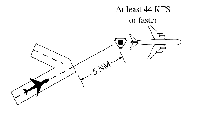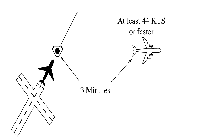The 44 Knot Rule
Recently Roddy and I were driving back home on a two lane state road out in the country. Very little traffic, but one Sunday driver ahead poking along around the speed limit. We were chit chatting about nothing in particular as Roddy came up behind her. With no oncoming traffic a factor, he pulled out, passed her, and at about the time the rear bumper of his Lincoln Navigator cleared the front bumper of the offending car, he eased the wheel over to slip back into our lane, all while never missing a beat in the conversation. We’ve discovered that we drive almost exactly the same, and we each have wives who don’t understand our driving. Either one of them would have been grabbing for the “oh, shit” handle and berating us for cutting it so close in returning to our lane. I, on the other hand, didn’t even blink an eye.
Also without blinking an eye, Roddy turned to me and said, “44 Knot Rule.”
That caused me to laugh, because I knew exactly what he meant, and so would any other air traffic controller, even if they didn’t drive like us. It all goes back to the rules for non-radar separation, as set out in our FAA Handbook, 7110.65, Air Traffic Procedures. I’m not going to try to make you into an air traffic controller here, but suffice to say that the rules for keeping airplanes apart without radar are steeped in history, much of which goes back to the 1930s. The Cliff Notes version is ten minutes or 1,000 feet, which means you have to provide either ten minutes between airplanes at a common point, or 1,000 feet in altitude between them. There are all sorts of refinements, such as when DME became common, at which point it was ten minutes or 20 miles for the longitudinal component.
But there were other rules which helped you get airplanes off the ground with minimal delay or which would permit employing aircraft characteristics to reduce the time interval. One of them was the “44 Knot Rule.” I've taken the liberty of lifting the pertinent paragraph from the actual 7110.65 and reproducing it below (some overly complicated material not relevant to the point have been edited out—click on thumbnail for larger image).
(The below doesn’t need to be read in depth—I provided it to demonstrate that the rule exists. Feel free to skip over it to the concluding paragraphs.)
Okay, it’s not so important to grasp the specific meanings of the sub-sections—it’s merely illustrative that by employing a fairly significant speed differential, one can reduce the necessary separation by up to 75%. It is common sense that it’s unnecessary to apply 10 minutes or 20 miles between two aircraft whose closest point will never be less than 3 minutes or 5 miles and will always be increasing. All controllers know this as the “44 Knot Rule.” and as can be seen from the story are able to apply it appropriately to situations away from work.
To put it in non-aviation terms, there is no danger in using fractions of a car length of separation between vehicles when the front one is significantly faster than the one behind, despite the consternation of non-ATC passengers.
Last updated: 03 September 2011



 Main Page
Main Page